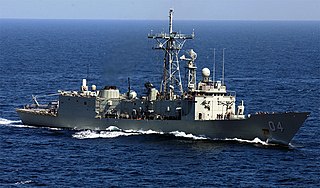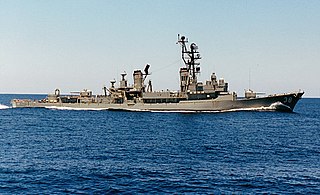See also
- RSS Stalwart, a frigate of the Republic of Singapore Navy.
- USS Stalwart, two ships of the United States Navy.
- USNS Stalwart (T-AGOS-1), a surveillance ship of the United States Military Sealift Command.
Two ships of the Royal Australian Navy (RAN) have been named HMAS Stalwart.

Five ships of the Royal Australian Navy (RAN) have been named HMAS Sydney, after Sydney, the capital city of New South Wales.

The Oliver Hazard Perry class is a class of guided-missile frigates named after the U.S. Commodore Oliver Hazard Perry, the hero of the naval Battle of Lake Erie. Also known as the Perry or FFG-7 class, the warships were designed in the United States in the mid-1970s as general-purpose escort vessels inexpensive enough to be bought in large numbers to replace World War II-era destroyers and complement 1960s-era Knox-class frigates. In Admiral Elmo Zumwalt's "high low fleet plan", the FFG-7s were the low capability ships with the Spruance-class destroyers serving as the high capability ships. Intended to protect amphibious landing forces, supply and replenishment groups, and merchant convoys from aircraft and submarines. They were also later part of battleship-centred surface action groups and aircraft carrier battle groups/strike groups. Fifty-five ships were built in the United States: 51 for the United States Navy and four for the Royal Australian Navy (RAN). In addition, eight were built in Taiwan, six in Spain, and two in Australia for their navies. Former U.S. Navy warships of this class have been sold or donated to the navies of Bahrain, Egypt, Poland, Pakistan, Taiwan, and Turkey.

A guided-missile destroyer is designed to launch anti-aircraft guided missiles. Many are also equipped to carry out anti-submarine, anti-air, and anti-surface operations. The NATO standard designation for these vessels is DDG. Nations vary in their use of destroyer D designation in their hull pennant numbering, either prefixing or dropping it altogether. The U.S. Navy has adopted the classification DDG in the American hull classification system.
Three ships and a naval base of the Royal Australian Navy have been named HMAS Brisbane after Brisbane, the capital city of Queensland.
Three ships of the Royal Australian Navy have been named HMAS Canberra, for Canberra, the capital city of Australia.
Three ships of the Royal Australian Navy (RAN) have been named HMAS Hobart, for Hobart, the capital city of Tasmania.
Four ships of the Royal Australian Navy been named HMAS Parramatta, for the Parramatta River. The name comes from the Barramattagal people.
Three ships of the Royal Australian Navy (RAN) have been named HMAS Perth after Perth, the capital city of Western Australia.
Three ships of the Royal Australian Navy (RAN) have been named HMAS Swan, for the Swan River in Western Australia.
Two ships of the Royal Australian Navy have been named HMAS Tobruk, after the town of Tobruk in Libya and the siege fought there in 1941.
Two ships and a shore establishment of the Royal Australian Navy (RAN) have been named HMAS Torrens, after the River Torrens.

The Charles F. Adams class is a ship class of 29 guided missile destroyers (DDG) built between 1958 and 1967. Twenty-three destroyers were built for the United States Navy, three for the Royal Australian Navy, and three for the West German Bundesmarine. The design of these ships was based on that of Forrest Sherman-class destroyers, but the Charles F. Adams class were the first class designed to serve as guided missile destroyers. 19 feet (5.8 m) of length was added to the center of the design of the Forrest Sherman class to carry the ASROC launcher. The Charles F. Adams-class destroyers were the last steam turbine-powered destroyers built for the U.S. Navy. Starting with the later Spruance-class destroyers, all U.S. Navy destroyers have been powered by gas turbines. Some of the destroyers of the Charles F. Adams class served during the blockade of Cuba in 1962 and during the Vietnam War. Destroyers of the Royal Australian Navy served during the Vietnam War and Gulf War.

The Adelaide class was a ship class of six guided missile frigates constructed in Australia and the United States of America for service in the Royal Australian Navy. The class was based on the United States Navy's Oliver Hazard Perry-class frigates, but modified for Australian requirements. The first four vessels were built in the United States, while the other two were constructed in Australia.

The Perth-class destroyers were three modified Charles F. Adams-class guided missile destroyers operated by the Royal Australian Navy (RAN). Ordered from Defoe Shipbuilding Company during 1962 and 1963, HMA Ships Perth, Hobart, and Brisbane were the first guided missiled-armed warships, and the first naval ships of United States design, to enter service with the RAN. All three ships operated during the Vietnam War, while Brisbane also participated in the Gulf War. The class was decommissioned between 1999 and 2001, with all three vessels later sunk as dive wrecks.
Two ships of the Royal Australian Navy (RAN) have been named HMAS Success.
HMAS Stalwart was an Australian-designed and constructed Escort Maintenance ship of the Royal Australian Navy (RAN). Commissioned on 9 February 1968 and decommissioned on 9 March 1990, Stalwart served as a destroyer tender, the RAN flagship, and a training vessel during her career. She was sold in 1993 for conversion into a short-range cruise ship, under the names MV Her Majesty M, then MV Tara II. The vessel did not enter civilian service before she was broken up for scrap in 2003.

HMAS Stalwart (H14) was an Admiralty S class destroyer of the Royal Australian Navy (RAN). Built for the Royal Navy during World War I, the ship was not completed until 1919, and spent less than eight months in British service before being transferred to the RAN at the start of 1920. The destroyer's career was uneventful, with almost all of it spent operating along the east coast of Australia. Stalwart was decommissioned at the end of 1925, was sold for ship breaking in 1937, then was scuttled in 1939.
Brisbane is the capital city of Queensland, Australia.
Two ships of the Turkish Navy have been named TCG Kılıç Ali Paşa:
At least two ships of the Hellenic Navy have borne the name Aetos :